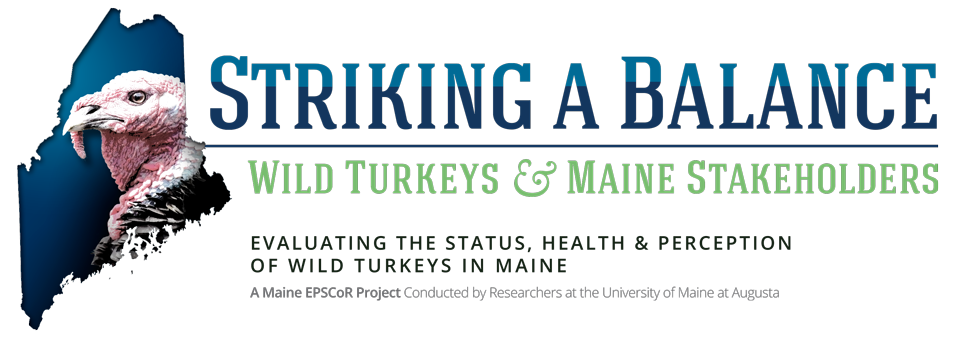NSF EPSCoR Evaluating Interactions Between Wild Turkeys and Maine Agriculture
Historically, wild turkeys (Meleagris gallopavo) existed in significant numbers in Maine. By the early 1800’s wild turkeys in Maine were completely eliminated due to unrestricted hunting and intensive agricultural practices resulting in the reduction of forested land. Since 1880, many farms have been abandoned and much of Maine’s land has reverted back to forest greatly enhancing wild turkey reestablishment. Successful reintroduction efforts began in the 1970’s. Currently a population of over 50,000 birds can be found across all 16 counties in Maine. Due to the overwhelming success of wild Maine turkey repopulation efforts, wild turkeys were added to the MDIFW nuisance wildlife policy in 2002 and some members of Maine’s agricultural community are experiencing economic losses and other effects of an existing and expanding turkey population. In addition to crop damage, turkeys are susceptible to a number of infectious diseases and may be in close contact with hunters, agricultural workers, and other animals. The extent of agricultural habitat use, agricultural impact, population genetic structure, and pathogen and microbiotic diversity of Maine’s wild turkeys is unclear.
Our research plan involves four separate components:
- population genetic analysis of Maine wild turkeys across the state,
- tagging and GIS analysis of select turkeys,
- pathogen and microbiological screening of Maine turkeys across the state, and
- analysis of stakeholder perceptions and acceptance capacity for the reintroduction of wild turkeys in Maine via survey procedures.
A total of 10 undergraduate interns worked on the microbiology and molecular genetics components in 2012. In addition to EPSCoR-funded undergraduate research time, 180 hours of undergraduate research time was supported by a UMS Maine Economic Improvement Fund award related to this project and 380 hours were volunteered by students or were spent doing research for credit. Data collected over the last year included the agricultural-stakeholder survey with over 300 responses, capture of domestic and wild turkeys from multiple sites in Maine, collection of —80 microbiology samples, —120 population genetics samples, —50 banded birds, and 1 satellite-receiver tagged bird.
Additional wild turkey samples are currently being located, captured, and sampled as logistics dictate. Survey results show clear concerns about the increasing turkey population in Maine from various components of Maine’s agricultural community. Laboratory work is ongoing.
